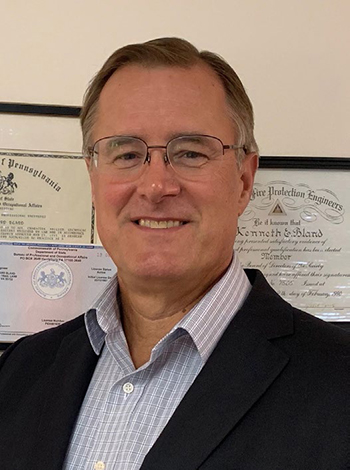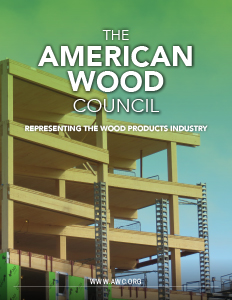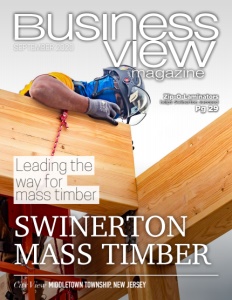The American Wood Council
Representing the wood products industry
Business View Magazine interviews representatives from the American Wood Council, as part of our focus on mass timber production in North America.
The American Wood Council (AWC) is the voice of North American wood products manufacturing, an industry that employs almost 450,000 men and women in the United States, with an annual payroll of over $21 billion. AWC represents 86 percent of the structural wood products industry, providing an organizational structure for wood products companies and associations to work together on building codes and standards, sustainability and green building policy issues, and a focused set of environmental regulations.
AWC is both one of the youngest and one of the oldest major trade groups in the nation. AWC was re-chartered in June 2010, evolving from a number of predecessor groups. Immediately prior to the founding of the new AWC, the forest products industry was represented by the American Forest & Paper Association (AF&PA). AF&PA grew out of two organizations – the National Forest Products Association (NFPA) and the American Paper Institute (API) – each an independent institution with some common membership. NFPA and API represented the forest and building products industries, and pulp, paper, and paperboard manufacturers, respectively.
NFPA’s lineage dates back to 1902, when regional associations, led by the Southern Lumber Manufacturers Association and the Mississippi Valley Lumbermen’s Association, founded the National Lumber Manufacturers Association. It operated under this name until 1965 when, reflecting the increasingly integrated character of major forest industry firms, it took on the NFPA identification. However, NFPA remained a federation of associations until 1975, when a bylaw revision made it possible for individual companies to join directly.
The American Wood Council, a previously independent trade association established by the wood products industry to provide generic promotion activities, was merged with NFPA’s building codes and engineering function in 1991. While today’s AWC bears the name of that former organization, the new AWC serves the modern wood products industry to address a wide-ranging set of challenges.
With its mission focused, AWC now contributes to the development of sound public policies, codes, and regulations that allow for the appropriate and responsible manufacture and use of wood products. AWC supports the utilization of wood by developing and disseminating consensus design standards, comprehensive technical guidelines on wood sustainability and use, and tools for wood design and construction, as well as providing education regarding their code-compliant design and application.
AWC has, in its ten-year existence, emerged as the leading voice for the wood products industry. When any matter of major concern relating to the industry surfaces at the state, national, or international level, AWC is an active presence on behalf of industry interests and its advice and counsel are both sought and respected. Through its effective advocacy and superior membership services, AWC is rapidly gaining recognition as one of the nation’s most powerful and effective trade associations. And this month, AWC is welcoming Jackson Morrill as the new President & CEO to take the place of Robert Glowinski, who is retiring at the end of the year after leading the organization since its move to an independent trade association.

“I come to AWC having served most recently as President of the Composite Panel Association (CPA), which represents the manufacturers of composite wood panels, including particleboard, medium density fiberboard, hardboard and engineered wood siding and trim,” Morrill says. “While a different segment of the wood products industry, there are still a number of shared issues that impact both AWC and CPA members, and I bring that experience and knowledge to this new position. I also served as the staff lead for advocacy at CPA, and I have 20 years of experience working on sustainability, environmental and other issues as a lawyer and trade association representative. I see both significant opportunities and some ongoing threats to structural wood products, and I look forward to working on behalf of the members to achieve results that support the continued growth of this important industry.”
AWC staff has also grown significantly over the past ten years, a reflection of strong member support for its mission. It now has approximately 40 people on its organizational chart, including 22 full-time employees and some who work part-time on its behalf on specific issues or operations. The staff works extensively on building codes, standards, and regulations and provide significant technical support and education to the broader building community on engineering and code matters related to the use of structural wood products.
AWC staff also play an important role in advocating for a legislative and regulatory level playing field at a national, state, and local level and educating policymakers on issues impacting the wood products sector. Its environmental policy group works primarily with federal agencies, most often EPA, that develop policies that regulate emissions from manufacturing facilities. AWC staff are also involved in sustainability and green building activities that range from the development of codes and standards that are written specifically for high-performance, green buildings to the development of environmental product declarations for wood products.

“If the industry isn’t represented in these forums, whether it’s a code development activity, or a legislative hearing, there is the possibility that something will come out of that process that’s unfavorable for wood product manufacturers, because we didn’t have a voice,” explains Kenneth Bland, Vice President for Codes and Regulations. “If you’re not there to represent and defend wood products, or to promote their structural characteristics, their sustainability attributes, and performance, then they very well may be left out of the conversation. And our members don’t want their products left out; they want to be in the foreground of these conversations. And that’s where a portion of their dues dollars go – to staff participating in technical meetings and legislative and regulatory hearings where building materials are on the agenda.”
“For example,” Bland continues, “over the past four years, we’ve been directly involved in a project with the International Code Council (ICC) to increase opportunities for mass timber products in building codes. We were a member of an ad hoc committee at ICC that studied the opportunity to expand the code to allow for taller and larger buildings constructed from mass timber products. The ICC has annual hearings to develop codes; any interested party can propose a change to the code, take it through the hearing process, and if the ICC governmental consensus voting membership approves of it, it will be in the next edition of the code. So, as a committee member we were involved in a series of changes that actually came from this ad hoc committee on tall wood buildings. It proposed to allow mass timber buildings up to 18 stories in height and much larger in area than what’s currently permitted by the 2018 Code for mass timber buildings.
“As part of the ad hoc committee’s research, there was extensive fire testing of mass timber conducted and the results were very reassuring to building and fire officials. The ad hoc committee studied research and developed proposals based on science and testing. During the 2018 and 2019 code development hearings the ICC membership heard testimony from the ad hoc committee and many other interested parties, before approving the allowances for tall mass timber. Historically the building code permitted wood frame buildings up to a maximum of 85 feet and six stories. What these new, recently-approved changes to the 2021 International Building Code will allow are mass timber buildings up to 18 stories and 270 feet in height. So, this really is an unprecedented change for the model building codes; unlike anything that’s occurred in the past 100 years of building code development. So, the industry and design community are pretty excited about that.
“And there’s also, now, quite a bit of emphasis on the environmental aspects of building materials and their role in mitigating the effects of climate change. We’re very proud of the fact that wood products are low-embodied carbon products; it takes very little fossil-based energy to manufacture wood products and they’re from a renewable and sustainable resource which absorbs and stores atmospheric CO2. When you look at some of the competing materials in the structural building system, they have high-embodied carbon due to an energy intensive manufacturing process. The more buildings that are constructed with wood, the lower the carbon emissions are to the atmosphere as a result of the products used to build that building. So, the architecture community is very excited about using low-embodied carbon building materials and that’s just a very strong proposition for wood products. And globally, there has been an increasing recognition that wood products offer a proven, safe, resilient, carbon sequestering alternative for improved sustainability and use. So, what we’re now focusing on is identifying the role for wood products in helping to mitigate climate change.”

Heather Stegner, AWC’s Vice President for Communications, relates some of the recent events that her office has dealt with concerning the COVID-19 pandemic and how it has affected AWC’s members:
“In mid-March, AWC received word that the federal government was creating a list of industries to be classified as ‘Essential Infrastructure’ that would be recommended for continued operations. We made immediate contact with the Department of Homeland Security’s Cyber and Infrastructure Security Agency (CISA) that was putting together the list, which the federal government would recommend (but not mandate), be allowed to remain open. AWC submitted a letter to CISA outlining the reasons wood products manufacturers should be considered ‘essential critical infrastructure.’ The letter was timely, as the Department, shortly thereafter, released federal guidance that included ‘workers who support the manufacture and distribution of forest products, including, but not limited to, timber, paper, and other wood products,’ in its list of essential workers.
“Subsequently, we learned that other companies in the wood industry supply chain had not been so designated, and AWC joined other manufacturing associations in supporting CISA’s inclusion of the supply chains of Essential Industries, which was then added to the definition of Critical Manufacturing. Discussion with the National Association of Home Builders (NAHB) followed, which indicated that construction had not been included as an essential industry, and AWC and other organizations joined a NAHB letter to CISA requesting that construction be a part of critical infrastructure, which was then included in version 2.0 of the CISA federal guidelines.
“While many states and local jurisdictions simply referenced the CISA guidelines, some states implemented their own unique lists. AWC joined the National Association of Manufacturers (NAM) and other organizations in letters to several state governors referencing the CISA list and urging them to allow manufacturers in their state to keep operating during the crisis. AWC had a specific success assisting a wood industry supplier in Michigan stay open by providing information to the Governor’s office citing the federal guidance.
“Moving forward, AWC is working in a number of different other areas to address issues related to the pandemic. In May, AWC’s President & CEO Robert Glowinski briefed the 75-plus members of the House Working Forest Caucus virtually, highlighting AWC’s top legislative priorities going forward to respond to COVID-19’s economic impact: support policies that boost housing, rental markets, and homeownership, including measures that can help keep people in their homes; maintain existing housing; and those that don’t exacerbate housing and rental problems. AWC also signed on to NAHB policy recommendations sent to the White House and Congress, intended to both help the residential construction industry and lead the economy out of the COVID-19-driven recession. Policy initiatives specifically being advocated by AWC include: Addressing the Construction Permitting Bottleneck and Providing Reasonable Safe Harbor Liability Protection.
“According to ICC, two-thirds of building and fire prevention departments reported working remotely at the height of the pandemic, but six in ten do not possess the capability to remotely carry out certain critical aspects of their work. This hinders departments’ ability to provide essential functions such as inspections and permitting. According to the survey, virtual capability needs have also led to significant delays, creating challenges for ongoing and future construction to help drive economic recovery. AWC joined 53 other organizations in a letter to Congress and the Administration encouraging additional federal resources to help building code departments develop virtual capabilities to adequately continue the permitting process. With many local building departments already under-resourced, and many state and local governments facing severe revenue downturns due to the COVID-19 epidemic, the letter communicated that building and fire prevention departments needed additional resources to continue their essential operations and urged the Administration to use existing authority to make funding available under the Disaster Relief Fund to assist departments.
“The resulting CARES Act provided $150 billion in assistance through a Coronavirus Relief Fund (CRF) for ‘necessary expenditures’ – by state, local, tribal, and territorial governments – to respond to the coronavirus pandemic. The Treasury Department then released guidance that lists, as an eligible expense under the CRF, ‘expenses to improve telework capabilities for public employees to enable compliance with COVID-19 public health precautions.’ AWC contacted Members of the House and Senate appropriating and authorizing committees to highlight this issue and support future funding if needed.
“Finally, AWC joined NAM and other manufacturers seeking tailored liability protections for manufacturers and other essential industries, asserting that manufacturers who operated as critical infrastructure, and in good faith, should not be punished by frivolous lawsuits. Some states have extended liability protection offered to health care workers to manufacturers, architects, engineers, and contractors aiding in the crisis. However, a national approach is needed to ensure uniformity in all states.
“Both Senate Majority Leader Mitch McConnell (R-KY) and House Minority Leader Kevin McCarthy (R-CA) have said they won’t agree to another stimulus bill that doesn’t include liability protection for businesses, while Democrats have expressed skepticism about the idea. The Senate Judiciary Committee held a hearing on it in May, with Leader McConnell and Sen. John Cornyn (R-TX), stating they would introduce a liability protection bill. AWC supports this effort and is working with Congressional allies to ensure targeted and limited safe harbor liability protection to protect the continued operation of critical infrastructure.”
AT A GLANCE
WHO: The American Wood Council
WHAT: A trade group representing the wood products industry
WHERE: Leesburg, Virginia
WEBSITE: www.awc.org


